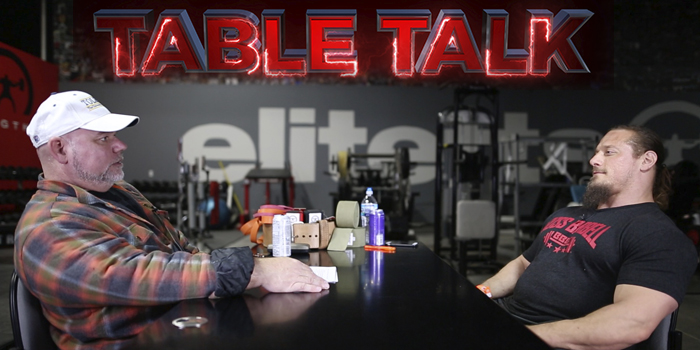
In the most recent Table Talk video, Dave Tate and Dan Green took a reader-submitted question about deloads and used it to drive an entire discussion around fatigue management. In similar fashion, for this week's Table Talk, Dave and Dan begin with a question about frequency and use that question as a starting point for a general discussion of the training principle.
Dan begins by saying that, when he first got into training, he was influenced by the bodybuilding-style approach to frequency, which consisted of three-times-per-week training of everything. With more modern advancements in training, Dan still prefers this approach with several alterations.
Dan likes the idea of training three times per week, and he says this works best when you have days that are light, days that are moderate, and days that are heavy in weight. Dan also uses variations of the lifts so that he isn't performing the same lift three times. For instance, he may do three different bench press variations during a week, with each of the three being done at different intensity levels. He has specific squat movements that he knows will work for him, which he performs three of each week, on two separate days. He also has a three-day frequency approach to the deadlift, with each week including:
- A heavy deadlift day
- A moderately heavy stiff-leg deadlift day
- A light day of rowing and accessory exercises
For bench, he likes a lot of shoulder pressing, including variations that are more triceps or volume focused. At this point in the conversation, Dave interjects with a follow-up question. While squat and deadlift variations tend to be fairly easy to select, the bench press variations are not so simple. How does Dan approach this?
WATCH: Table Talk with Dan Green — Deloads and Fatigue Management
Dan's response is that, for each exercise that he uses, he knows a rep range that works well for it, which he has learned through experimentation. For instance, wide grip benching is good for six to eight reps, used as a higher volume exercise. Conversely, the military press can be used for low, medium, or high reps, with various intensity levels. Heavy or light, Dan is able to use military press to his advantage. To clarify the difference between a "heavy day" for an exercise and a "light day" for an exercise, Dave has Dan give specific weight and rep ranges. Specifically for seated military press, Dan shares that a heavy day would be sets of five with roughly 300 pounds, while a light day would be sets of around 10 reps with somewhere between 225 and 245 pounds.
At this point, Dave points out that progressing these "light days" in weight over time must be done in a very controlled fashion. If you continually increase weight on these days or don't start at a low enough percentage, the days that are intended to be light very quickly become heavy days and your entire recovery for the program deteriorates. Dan adds that, if the light sets make up a lot of your volume, you want to make sure that as you increase the weights, you don't drop the volume too quickly. Despite being much lighter in weight, the high rep days make up the majority of your training volume, and when you increase weight and decrease reps, you want to ensure your total volume doesn't take too big of a hit. The tricky thing about this is that a decrease in volume will make you feel better in the first few weeks it occurs, but several weeks later your program will stall and you'll feel weaker. It takes time for the negative effect to set in, which can make it difficult to monitor.









